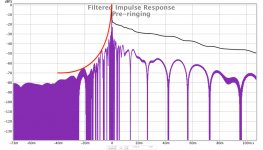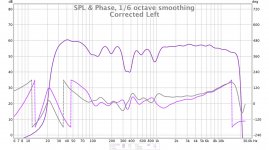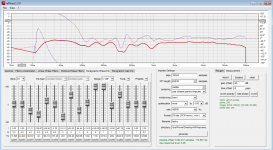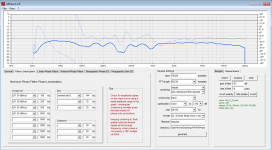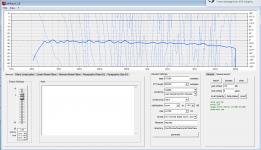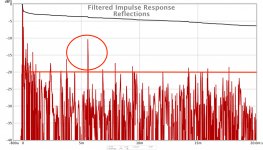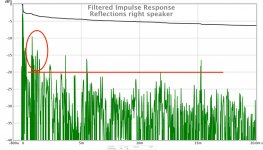Hi, SwissBear.
Thank you for explanation, I cant find detailed guide how to do it.
Question: What is it "measurements with 6 cycles FDW"?
So, I also have a strange phase in my system, what wrong with it?
Thank you for explanation, I cant find detailed guide how to do it.
Question: What is it "measurements with 6 cycles FDW"?
So, I also have a strange phase in my system, what wrong with it?
Last edited:
Question: What is it "measurements with 6 cycles FDW"?
So, I also have a strange phase in my system, what wrong with it?
FDW is Frequency Dependent Window: see attached example.
Please post your phase measurement as an image attached to your post.
Attachments
Thank you! System is 4-way NanoDIGI.FDW is Frequency Dependent Window: see attached example.
Please post your phase measurement as an image attached to your post.
IIR XO points are:
LF - 144Hz 18db BW XO (vented box)
MB - 144Hz 18BW >>>> 1500HZ 24LR (closed box)
Mid - 1500Hz 24LR >>>> 7000Hz 18BW (waveguide)
High - 7000Hz 18BW >>>>> (waveguide)
Attachments
Last edited:
OK. I had a look.
SPL is super clean and does not need any adjustment IMHO.
As far as phase is concerned, I am not a specialist, but I could not find any 'academic' way to solve the pb.
I used following settings to reach a phase which is not too far from minimum phase. This solution produces pre-ringing, but this should not be audible.
Once again, there are probably much better solutions.
May be Pos or one of the seniors here have an idea ?
SPL is super clean and does not need any adjustment IMHO.
As far as phase is concerned, I am not a specialist, but I could not find any 'academic' way to solve the pb.
I used following settings to reach a phase which is not too far from minimum phase. This solution produces pre-ringing, but this should not be audible.
Once again, there are probably much better solutions.
May be Pos or one of the seniors here have an idea ?
Attachments
Hello,
SwissBear, that is a big amount of phase correction you proposed!
Imho, this measurement is not so reliable to base a phase correction on it,
probably too much reflected sound creating "virtual" phase wrapping,
i'd try with a measurement at shorter distance to mainly reflect loudspeakers.
cdt
SwissBear, that is a big amount of phase correction you proposed!
Imho, this measurement is not so reliable to base a phase correction on it,
probably too much reflected sound creating "virtual" phase wrapping,
i'd try with a measurement at shorter distance to mainly reflect loudspeakers.
cdt
Hi Jimbee,
I fully agree with you. A first step could be to reduce the number of cycles from 6 to 3 and watch. Your idea to make a short distance measurement probably is better though.
I fully agree with you. A first step could be to reduce the number of cycles from 6 to 3 and watch. Your idea to make a short distance measurement probably is better though.
Thank you! System is 4-way NanoDIGI.
IIR XO points are:
LF - 144Hz 18db BW XO (vented box)
MB - 144Hz 18BW >>>> 1500HZ 24LR (closed box)
Mid - 1500Hz 24LR >>>> 7000Hz 18BW (waveguide)
High - 7000Hz 18BW >>>>> (waveguide)
Hi, I have no idea if this will help with all your phase rotation across the spectrum, because most of my experience in correcting phase is driver by driver.
But my first step is to try Filters Linearization against whatever Minimum-Phase Filters I'm using. So the attached would be my first poke at it..
Your two 18BW @ 270 deg rotation each, and one 24LR @ 360 deg should add up to 900 degrees, which at least totals correctly against the attached..
Any particular reason you're using 18BW instead of say 24 LR?
Attachments
Hello,
SwissBear, that is a big amount of phase correction you proposed!
Imho, this measurement is not so reliable to base a phase correction on it,
probably too much reflected sound creating "virtual" phase wrapping,
i'd try with a measurement at shorter distance to mainly reflect loudspeakers.
cdt
Hi Jimbee,
I fully agree with you. A first step could be to reduce the number of cycles from 6 to 3 and watch. Your idea to make a short distance measurement probably is better though.
If member ustas is okay experiment a bit have suggestion that don't need redo any measurements but process them a bit as base for making correction. Method is shared another thread by member gmad so as to correct speaker with measurements at listening position (LP) including in room actual situation that mostly ruin anechoic perfect corrected speakers acoustics performance at LP : (
First step is correct as jmbee say too much reflected sound creating "vitual" phase wrapping by extracting minimum phase that belong to actual frq response. Process is into REW if impulse response (IR) isn't aligned then use "Estimate IR delay" button, then "Generate minimum phase" button and "File/Export/Export impulse response as WAV", in dialog tick "mono" " 16 24 or 32-bit" and "Export Min Phase Version of IR".
Second step is into REW "File/Import impulse response" import before saved IR-wav file, now hit button "IR Windows" and tick "Add frequency dependent window" "(FDW) setting "Width in octaves" to 1/6 and use button "Apply Windows". Now suggest user to save session in REW else all these commands and settings need to be redone next time opening this MDAT-file session.
This minimum phase extracted and first wave filtered (FDW) acoustics situation is the new base to make corrections be it IRR or FIR executed in REW's EQ section or Rephase or another program, to get this base over in Rephase export as frd or txt file.
Few times myself used above procedure for a system correction it worked very well and think has potential to improve on LP acoustic performance. Experimenting think it also can be used base correction at LP for individual band-pass in multi way too so as most correct as possible target slope in acoustic domain for each band-pass will be present at LP. That said had not had time look into member ustas specific setup was it near or far field at LP measured and if above can help him, but if remember correct in past when posted here about same procedure one member reported back it was better method to system correct his passive multiway speaker than other experiments he had tried.
Last edited:
Look at the IR first, are there early reflections? If there are, all bets are off. Phase will change due to these early reflections. REW can tell you when. Look at that phase while setting it to one cycle frequency dependent window, two cycles and then three and so on, Look for changes in FR and phase. Connect reflections to that change and you learn when a reflection eats away at the frequency curve and where.
Reflections change geometrically when you change position. It's better to solve those with damping, speaker placement or diffusion. If you EQ it out, it will make a change for the worse once you move a little. Get rid of the reflection and the FR will clean up even without EQ.
Another helper: look at a wavelet to confirm what you saw with the frequency depended window and see that wave develop by scrolling the though the window size in milliseconds. Reflections don't happen at the start of that wave front (unless they are really really early, -> See IR) if you see a dent at the start of the wave front, you probably can fix it. If you see a sort of hole in the wavelet graph, it's most probably something room related, meaning you shouldn't want to fix it with phase EQ. You can still cover it up some in the frequency graph, check for trends with multiple measurements.
If the IR is clean, and the filtered IR shows the reflections are down by ~-20 dB, EQ the frequency response based on the method in the post above from BYRTT, 1/6 window or 5-6 cycles. If you do it in REW you can either have the IR or the early waterfall on the bottom window. You can actually see the waterfall clean up with PEQ cuts. Small cuts usually drop ridges seen in the waterfall by more dB than the negative PEQ gain you use. Get the FR back in shape with a more broad Q (wider area) boost.
At least, that's about what I would recommend. Believe me, getting that IR /filtered IR as clean as possible first is mandatory. Unless you want to listen with your head locked at one spot. I don't want that, do you?
Personally I think EQ-ing the phase flat from a 6 cycle window wouldn't be a smart thing to do, as the wave build up at low frequencies means your correcting phase from room anomalies, look up how many milliseconds 6 cycles is in the lower frequencies.
Phase is unique to that spot where you measure. Move a bit and phase changes. So any phase correction should be done with care. Learn to read your room.
Hope this helps...
Reflections change geometrically when you change position. It's better to solve those with damping, speaker placement or diffusion. If you EQ it out, it will make a change for the worse once you move a little. Get rid of the reflection and the FR will clean up even without EQ.
Another helper: look at a wavelet to confirm what you saw with the frequency depended window and see that wave develop by scrolling the though the window size in milliseconds. Reflections don't happen at the start of that wave front (unless they are really really early, -> See IR) if you see a dent at the start of the wave front, you probably can fix it. If you see a sort of hole in the wavelet graph, it's most probably something room related, meaning you shouldn't want to fix it with phase EQ. You can still cover it up some in the frequency graph, check for trends with multiple measurements.
If the IR is clean, and the filtered IR shows the reflections are down by ~-20 dB, EQ the frequency response based on the method in the post above from BYRTT, 1/6 window or 5-6 cycles. If you do it in REW you can either have the IR or the early waterfall on the bottom window. You can actually see the waterfall clean up with PEQ cuts. Small cuts usually drop ridges seen in the waterfall by more dB than the negative PEQ gain you use. Get the FR back in shape with a more broad Q (wider area) boost.
At least, that's about what I would recommend. Believe me, getting that IR /filtered IR as clean as possible first is mandatory. Unless you want to listen with your head locked at one spot. I don't want that, do you?
Personally I think EQ-ing the phase flat from a 6 cycle window wouldn't be a smart thing to do, as the wave build up at low frequencies means your correcting phase from room anomalies, look up how many milliseconds 6 cycles is in the lower frequencies.
Phase is unique to that spot where you measure. Move a bit and phase changes. So any phase correction should be done with care. Learn to read your room.
Hope this helps...
Last edited:
...Hope this helps...
Pretend it 😀 but first will have to redo all measurements from listening position (LP) instead of usual near field stuff but great thanks taking time share 😉 experience to improve on in room acoustics quality at LP.
My initial thoughts from post is there looks to be some big diy work ahead with nose deep into REW for better understanding to be worked out, opening same measurement multiple times with different window settings and toggle various tabs to make right decisions what to physical correct in room and what let DSP correct be it IRR or FIR and what not to correct or just dress up a little.
That's the idea, yes. 🙂
You can be the judge of it if I was successful at accomplishing that 😉.
It doesn't matter what tools you'd use, it's what you do with, how you use them that counts.
There are a lot of ways to get it wrong. I'm still learning how to get it "as right as possible".
At least for my room and speakers. And all of my personal compromises (think of Jim's room 😀).
You can be the judge of it if I was successful at accomplishing that 😉.
It doesn't matter what tools you'd use, it's what you do with, how you use them that counts.
There are a lot of ways to get it wrong. I'm still learning how to get it "as right as possible".
At least for my room and speakers. And all of my personal compromises (think of Jim's room 😀).
Last edited:
That's the idea, yes. 🙂
You can be the judge of it if I was successful at accomplishing that 😉.
It doesn't matter what tools you'd use, it's what you do with, how you use them that counts.
There are a lot of ways to get it wrong. I'm still learning how to get it "as right as possible".
At least for my room and speakers. And all of my personal compromises (think of Jim's room 😀).
For this thread to understand my role as judge told above will probably need little explanation.
Today 2 weeks ago together member xrk971 visited Netherlands and had a listening in wesayso's living room enviroment and sound quality is absolut world class acoustic performance, so can't stop saying here for interested Rephase users that paying attention to hints shared in post 1389 is probably not bad idea as diy to learn and improve acoustic sound in room.
In relation to what Rephase users probably seek for hope wesayso is alright attach little ala thumbnail sized data teaser for his system here that think is exceptional in that plots are acoustic performance of stereo pair at listening position in a normal looking living room and not any near field or smoothed measurements stuff, data looks impressive and so is sound quality.
Link wesayso's shared speaker and system build including visitors http://www.diyaudio.com/forums/full...driver-full-range-line-array.html#post3624487.
Link for info Jim's room 😀 https://www.gearslutz.com/board/studio-building-acoustics/817205-my-listening-room.html.
Attachments
Last edited:
Hi, ALL, and thanks a lot for all people who try to help me.
The biggest problem of my system is my listening room, sure. It's is 5,80m x 5,85 x 2,90m with two non symmetrical windows. Speakers placed in the corners of room (WAF🙂), listening position (LP) in front of a wall of speakers (near wall).
LF speakers, Aurasound 1808 in a modded "Jensen Corner Cabinets" (BTW this is BLH). How and where can measure response of that in near field I don't know.
MB speakers 14L. closed box with JBL2012.
Major sound problem was 80-200Hz area. For example: 120Hz : +6dB, 125Hz : -12dB, if inverting polarity of one speaker vice versa: 120Hz : -12dB, 125 : +6dB. This is because absolutely incomprehensible phases unevenness from BLH.
Just with 18BW XO I can reach current FR. Тhe measurement is made in LP (one point).
Today I did as SwissBear said.... Result is WOW!!! I found THE MID-BASS!!!!
Here files of FR and RePhase corrections: download
Have a one question: can it worth of time to try use RePhase with 15 or more cycles FDW?
The biggest problem of my system is my listening room, sure. It's is 5,80m x 5,85 x 2,90m with two non symmetrical windows. Speakers placed in the corners of room (WAF🙂), listening position (LP) in front of a wall of speakers (near wall).
LF speakers, Aurasound 1808 in a modded "Jensen Corner Cabinets" (BTW this is BLH). How and where can measure response of that in near field I don't know.
MB speakers 14L. closed box with JBL2012.
Major sound problem was 80-200Hz area. For example: 120Hz : +6dB, 125Hz : -12dB, if inverting polarity of one speaker vice versa: 120Hz : -12dB, 125 : +6dB. This is because absolutely incomprehensible phases unevenness from BLH.
Just with 18BW XO I can reach current FR. Тhe measurement is made in LP (one point).
Today I did as SwissBear said.... Result is WOW!!! I found THE MID-BASS!!!!
Here files of FR and RePhase corrections: download
Have a one question: can it worth of time to try use RePhase with 15 or more cycles FDW?
Last edited:
Hi ustas,Have a one question: can it worth of time to try use RePhase with 15 or more cycles FDW?
Thanks for the feedback.
In fact, it would be safer in your case to reduce the size of the FDW down to 3 cycles.
The larger the window, the more rooms reflections you include. In my environment, I usually find 6 cycles appropriate. But at Jmbee underlined, this is leading to a lot of phase adjustment. May be too much.
With rePhase, like with Acourate, you need to find a balance and judge with your ears what is best in your environment.
So try with 3 cycles just to judge how you feel about it.
Also, you could have a look at the reflections in your room. See attached graph of your left speaker. You have something potentially noisy at 5ms, which is 5x0.34 = 1.7m additional distance from your speaker to the listening position. This might be your roof or something else which is worth treating with a panel.
Please note that the right speaker shows reflection at different times. This is something you might want to sort out in order to improve your listening. You will also probably notice that rooms correction with rePhase does have positive influence on reflections. In my room, they are decreased by 5db when correcting with rePhase.
Attachments
Hi ustas,
Thanks for the feedback.
In fact, it would be safer in your case to reduce the size of the FDW down to 3 cycles.
The larger the window, the more rooms reflections you include. In my environment, I usually find 6 cycles appropriate. But at Jmbee underlined, this is leading to a lot of phase adjustment. May be too much.
With rePhase, like with Acourate, you need to find a balance and judge with your ears what is best in your environment.
So try with 3 cycles just to judge how you feel about it.
Also, you could have a look at the reflections in your room. See attached graph of your left speaker. You have something potentially noisy at 5ms, which is 5x0.34 = 1.7m additional distance from your speaker to the listening position. This might be your roof or something else which is worth treating with a panel.
Please note that the right speaker shows reflection at different times. This is something you might want to sort out in order to improve your listening. You will also probably notice that rooms correction with rePhase does have positive influence on reflections. In my room, they are decreased by 5db when correcting with rePhase.
Room is near "empty", few chairs, sofa, little table ... When I listen "Image" go more left position on HF. With RePhase filters, image is more stable - 100%.
Ok, I'm already making 35 FDW! 🙂 After it 3 FDW. In Monday I will post results here.
Thank you!
P.S. : Noice from 1,7m this is my desktop computer, forget to power off ... 😛
P.S. : Noice from 1,7m this is my desktop computer, forget to power off ... 😛
Does it help to lower a reflection to power off a desktop PC? That's news for me 😱.
I think Swissbear was referring to the large peak, as seen in the filtered IR plots. Not an actual noise source. A relative empty room will have more "room effect" than one filled with absorbing and/or diffusive elements, for example a filled bookcase.
UPS .. I think "noise" like source. BTW it can be a tatami table ... 🙂Does it help to lower a reflection to power off a desktop PC? That's news for me 😱.
I think Swissbear was referring to the large peak, as seen in the filtered IR plots. Not an actual noise source. A relative empty room will have more "room effect" than one filled with absorbing and/or diffusive elements, for example a filled bookcase.
Turning off all noise is always helpful, that would give you a lower room noise. Personally I hate that I live in a busy street and couldn't turn off the traffic 😀.
If you can battle the reflections passively it will be more successful than using DSP.
DSP can help the graphs, but like I said, move the mic and that advantage isn't there anymore as the reflection's interference moves with position.
EQ-ing a 6 FDW for frequency is better than using a longer window. It's not a bigger is better kind of thing. Phase is best to play it save, as too much correction would adjust the timing of a room anomaly. Even if the plot at the listening spot is improved.
Move from side to side while listening.
Solving the early reflections will free up the stereo image. Reflections kind of make you hear the speaker positions.
If you can battle the reflections passively it will be more successful than using DSP.
DSP can help the graphs, but like I said, move the mic and that advantage isn't there anymore as the reflection's interference moves with position.
EQ-ing a 6 FDW for frequency is better than using a longer window. It's not a bigger is better kind of thing. Phase is best to play it save, as too much correction would adjust the timing of a room anomaly. Even if the plot at the listening spot is improved.
Move from side to side while listening.
Solving the early reflections will free up the stereo image. Reflections kind of make you hear the speaker positions.
Hi all,
I can't seem to find any info on 'IR Windows' in the REW help files.....can anybody point me to some?
Making a real effort to finally get facile with REW.....especially since the new level of coordination with rePhase
Thank You ! mark
I can't seem to find any info on 'IR Windows' in the REW help files.....can anybody point me to some?
Making a real effort to finally get facile with REW.....especially since the new level of coordination with rePhase
Thank You ! mark
Hi all,
I can't seem to find any info on 'IR Windows' in the REW help files.....can anybody point me to some?
Making a real effort to finally get facile with REW.....especially since the new level of coordination with rePhase
there is a brief summary in Impulse Responses
what sort of info are you after?
- Home
- Design & Build
- Software Tools
- rePhase, a loudspeaker phase linearization, EQ and FIR filtering tool


